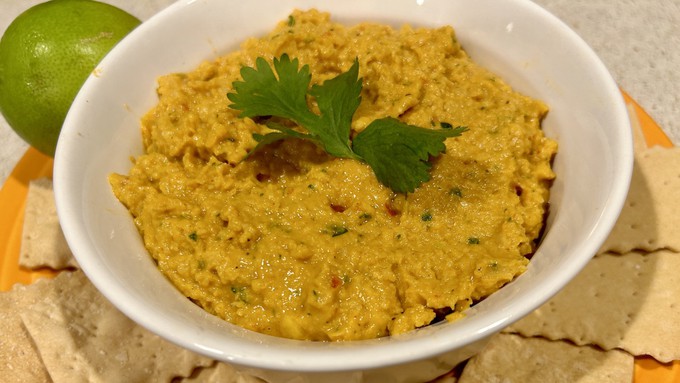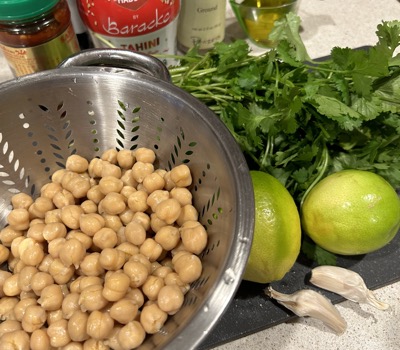
Recipe: Lime, cilantro and chilis flavor this easy dip

Serve this hummus among Thanksgiving appetizers or at any holiday party. Kathy Morrison
Lime is not thought of as a Thanksgiving flavor. Yet my little lime tree is loaded with fruit this year, and it all seems to be ripening at once.
I wanted a savory recipe using limes, and lucked into a cache of hummus recipes that I adapted for my limes and my family's fairly high tolerance of spiciness.
The recipe is easy, vegan, can be done ahead of time, and as an appetizer won't spoil anyone's hunger for sage or cinnamon or cranberries. It also won't supplant a family favorite while the cook tries something new.
Serve it with crackers or raw vegetables, and dig in while the rest of the meal is still cooking.
Lime-chili hummus with cilantro
Makes about 2 cups
Ingredients:
One 15.5-ounce can chickpeas, drained and rinsed
1 to 2 cloves garlic, minced
3 tablespoons plus 1 teaspoon extra virgin olive oil
2 tablespoons Chinese-style chili paste (or less, to taste)
1 tablespoon tahini (sesame paste)
1 tablespoon chopped fresh cilantro leaves, plus more for garnish
1 teaspoon ground coriander
Zest of 1 lime
2 tablespoons fresh lime juice, or more as needed

Salt and freshly ground black pepper to taste
Instructions:
Place the drained chickpeas, garlic and olive oil in a food processor or blender. Whir until the chickpeas are broken up and starting to become paste. Add the rest of the ingredients and blend to desired texture.
Taste the hummus and adjust the seasonings. Add a bit more lime juice if the texture is too thick.
Serve immediately with crackers or raw vegetables, or cover tightly and refrigerate until ready to serve. Again, add a touch of lime juice if it has thickened up too much.
Comments
0 comments have been posted.Sacramento Digs Gardening to your inbox.
Sites We Like
Garden Checklist for week of April 21
This week there’s plenty to keep gardeners busy. With no rain in the immediate forecast, remember to irrigate any new transplants.
* Weed, weed, weed! Get them before they flower and go to seed.
* April is the last chance to plant citrus trees such as dwarf orange, lemon and kumquat. These trees also look good in landscaping and provide fresh fruit in winter.
* Smell orange blossoms? Feed citrus trees with a low dose of balanced fertilizer (such as 10-10-10) during bloom to help set fruit. Keep an eye out for ants.
* Apply slow-release fertilizer to the lawn.
* Thoroughly clean debris from the bottom of outdoor ponds or fountains.
* Spring brings a flush of rapid growth, and that means your garden is really hungry. Feed shrubs and trees with a slow-release fertilizer. Or mulch with a 1-inch layer of compost.
* Azaleas and camellias looking a little yellow? If leaves are turning yellow between the veins, give them a boost with chelated iron.
* Trim dead flowers but not leaves from spring-flowering bulbs such as daffodils and tulips. Those leaves gather energy to create next year's flowers. Also, give the bulbs a fertilizer boost after bloom.
* Pinch chrysanthemums back to 12 inches for fall flowers. Cut old stems to the ground.
* Mulch around plants to conserve moisture and control weeds.
* From seed, plant beans, beets, cantaloupes, carrots, corn, cucumbers, melons, radishes and squash.
* Plant onion sets.
* In the flower garden, plant seeds for asters, cosmos, celosia, marigolds, salvia, sunflowers and zinnias.
* Transplant petunias, zinnias, geraniums and other summer bloomers.
* Plant perennials and dahlia tubers for summer bloom.
* Mid to late April is about the last chance to plant summer bulbs, such as gladiolus and tuberous begonias.
* Transplant lettuce seedlings. Choose varieties that mature quickly such as loose leaf.